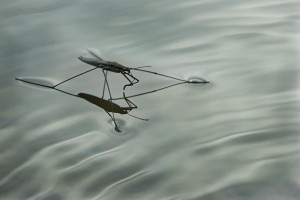As children, you may remember being fascinated by pond skaters and their ability to walk on water. This is due to water’s high surface tension and there are numerous other ways in which this property is vital to many biological functions. It is also an important factor to take into account when it comes to engineering, and therefore it is essential that there is an accurate and straight forward method for measuring surface tension.
many biological functions. It is also an important factor to take into account when it comes to engineering, and therefore it is essential that there is an accurate and straight forward method for measuring surface tension.
To measure this property, the pressure has to be reduced to such an extent that it causes the water to rupture and form vapour cavities. These vapour cavities must be a result of homogeneous nucleation alone and not heterogeneous nucleation (so should occur spontaneously and randomly, rather than due to nucleation sites). The pressure at which cavitation occurs in termed the tensile strength.
Previous methods have shown a large discrepancy in results, due to the requirement of large volumes of water leading to heterogeneous nucleation. More recently, the mineral inclusion method has overcome this, however has other limitations, such as the requirement of an autoclave. Alternatively, microfluidics allows the use small volumes of water to ensure homogenous nucleation, but this method is limited to low-viscosity liquids.

Dr. Liu Ai Lin and co-workers, at NTU, Singapore, have reported the direct measurement of water’s tensile strength using an optofluidic chip. Their method relies on an infrared laser that is focussed into a microchannel partially filled with water. The laser pulse results in the formation and recombination of plasma, which in turn produces a bubble, causing a spherical shock wave. The reflection of the shock wave on the air-water interface generates a negative pressure and, if this is larger than the tensile strength, the water ruptures, causing nucleation of vapour bubbles near the interface. The pressure value can be attained by both measuring the spreading of the shock wave over time and the displacement of the water-air interface.
By imaging the microchannel at increasing standoff distances (defined in the diagram above), the distance and pressure at which water no longer ruptures can be found. This can be directly converted to a value for the tensile strength.

This work provides a simple, low-cost method for calculating tensile strength that can easily allow rapid testing of a wide range of samples. In order to demonstrate this, the authors also measured the tensile strength of glycerol, a highly viscous fluid.
To download the full article for free* click the link below:
Water’s tensile strength measured using an optofluidic chip
Z. G. Li, S. Xiong, L. K. Chin, K. Ando, J. B. Zhang and A. Q. Liu
DOI: 10.1039/ C5LC00048C
*Access is free through a registered RSC personal publishing account










